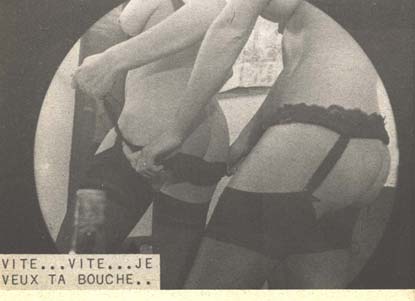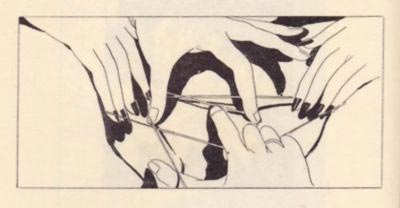relationships

Female sexuality is particularly enigmatic, simply because the sex function in women is so much more complex than that of their male counterparts. A study conducted by Dutch scientist Gert Holstege showed that while the areas in male brains activated during orgasm were not surprising, the activated areas in the female brains were slightly different. For one, the female brain becomes noticeably silent in certain areas, like in the lateral orbitofrontal cortex and the dorsomedial prefrontal cortex, two areas in the brain that process feelings and thoughts associated with self-control and social judgement. Holstege noted that “at the moment of orgasm, women do not have any emotional feelings.” (…)
Even women in good health have a difficult time achieving climax. Reportedly, 10% of women have never had an orgasm, and as many as 50% of women have trouble being aroused.
{ BrainBlogger | Continue reading }
neurosciences, relationships, sex-oriented | July 5th, 2011 3:40 pm

Imagine you are a single, heterosexual woman. You meet a nice man at the driving range, or on a blind date. You like him and he likes you. You date, you get engaged, you get married. You decide to have a child together, so you go off the pill. One morning you wake up and look at your husband, and it’s like seeing him through new eyes. Who is this stranger you married, and what did you ever see in him?
After some articles made the news when they suggested mate preferences change on hormonal contraception, this seemed to be the scenario in the heads of many women. Is my pill deceiving me? What if my birth control is making me date the wrong man?
Several articles over the years have demonstrated that women prefer men with more masculine features at midcycle, or ovulation, and more feminine features in less fertile periods. Based on body odor, women and men also often prefer individuals with MHC (major histocompatibility complex) that are different from theirs, which may be a way for them to select mates that will give their offspring an immunological advantage. These findings have been replicated a few times, looking at a few different gendered traits. And as I suggested above, other work has suggested that the birth control pill, which in some ways mimics pregnancy, may mask our natural tendency to make these distinctions and preferences, regarding both masculinity and MHC.
{ Context and Variation | Continue reading }
image { Thanks Glenn! }
neurosciences, relationships, science | July 5th, 2011 3:33 pm

First impressions are important, and they usually contain a healthy dose both of accuracy and misperception. But do people know when their first impressions are correct? They do reasonably well, according to a recent study.
Sometimes after meeting a person for the first time, there is a strong sense that you really understand him or her—you immediately feel as if you could predict his or her behavior in a variety of situations, and you feel that even your first impression would agree with those of others who know that person well. That is, your impression feels realistically accurate (Funder, 1995, 1999). Other times, you leave an interaction feeling somewhat unsure about how accurate your impression is—it is not clear how that individual would behave in different situations or what his or her close friends and family members would say about him or her. Are such intuitions about the realistic accuracy of one’s impressions valid? That is, do people know when they know? The current studies address this question by examining the extent to which people have accuracy awareness—an understanding of whether their first impressions of others’ personalities are realistically accurate.
{ Social Psychological and Personality Science | Continue reading }
photo { Harry Callahan }
psychology, relationships | July 1st, 2011 4:45 pm

{ A black-headed female Gouldian finch, Erythrura gouldiae, chooses her mate. Having a genetically incompatible mate can increase a female bird’s stress hormone levels which then can affect the sex ratio of her offspring. | Nature | Continue reading }
related { Effects of stress can be inherited, and here’s how }
birds, relationships, science | June 28th, 2011 1:16 pm
relationships, science | June 27th, 2011 1:55 pm

Is male libido the ultimate cause of war?
Across four experiments Lei Chang and his team showed that pictures of attractive women or women’s legs had a raft of war-relevant effects on heterosexual male participants, including: biasing their judgments to be more bellicose towards hostile countries; speeding their ability to locate an armed soldier on a computer screen; and speeding their ability to recognise and locate war-related words on a computer screen.
Equivalent effects after looking at pictures of attractive men were not found for female participants.
{ BPS | Continue reading }
fights, genders, relationships, science | June 27th, 2011 1:50 pm

{ 1 | 2 }
relationships, visual design | June 27th, 2011 1:40 pm

Despite growing numbers of singles, the idealization of marriage and child rearing remains strong, pervasive, and largely unquestioned. Guided by life course perspective, the purpose of this article was to examine familial and societal messages women receive when not married by their late 20s to mid-30s. (…)
Women, when compared with men, experience more pronounced pressure to confirm to the “Standard North American Family” ideology and this may be especially true after 9/11, when mainstream messages strongly promoted tra- ditional ideologies of gender and families. Accepted notions of femininity remain based on women having a connection with a man to protect and care for her. Such constructions reflect Rich’s argument that “compulsory heterosexuality” is a controlling force in women’s lives. Compulsory heterosexuality positions the heterosexual romantic relationship within a patriarchal context as natural, normative, and the most desirable of all relationships. Furthermore, the dic- tate of motherhood and the coupling of marriage and motherhood further encourage women to enter into marriage.
Despite such ideologies, increasing proportions of women are single, with 41% of women aged 25 to 29 years and 24% of women aged 30 to 34 years having never married (U.S. Census Bureau, Statistical Abstract of the United States, 2007).
{ SAGE | Continue reading }
related { Psychologists find link between ovulation and women’s ability to identify heterosexual men }
photo { Alonzo Jordan }
U.S., relationships | June 22nd, 2011 5:47 pm

What Makes a Team Smarter? More Women.
There’s little correlation between a group’s collective intelligence and the IQs of its individual members. But if a group includes more women, its collective intelligence rises. (…)
The standard argument is that diversity is good and you should have both men and women in a group. But so far, the data show, the more women, the better. (…)
Many studies have shown that women tend to score higher on tests of social sensitivity than men do. So what is really important is to have people who are high in social sensitivity, whether they are men or women.
{ Harvard Business Review | Continue reading }
genders, psychology, relationships | June 22nd, 2011 3:27 pm

Husband’s employment status threatens marriage, but wife’s does not, study finds.
A new study of employment and divorce suggests that while social pressure discouraging women from working outside the home has weakened, pressure on husbands to be breadwinners largely remains.
The research, led by Liana Sayer of Ohio State University and forthcoming in the American Journal of Sociology, was designed to show how employment status influences both men’s and women’s decisions to end a marriage.
{ EurekAlert | Continue reading }
economics, relationships | June 20th, 2011 9:05 pm

Social hierarchies are quite complicated. In the animal world hierarchies are wildly different based on social contexts, species, and environmental factors. For some animals, such as bull elephant seals, hierarchies are unstable—individuals spend a relatively short times at the top of the food chain—and what these alpha males get in terms of mating preferences, they pay dearly for in terms of physical fighting, aggressive confrontation, and threats from other male rivals. In unstable hierarchies, it’s hard to be at the top.
Most hierarchies are much more stable than the example of the bull elephant seal. For instance, in human social life, social hierarchies are typically stable within a specific context. For example, you and your boss aren’t likely to switch roles halfway through the year. And there is good reason for that. If people were allowed to switch willy-nilly between high and low status roles, it would be hard to know who to turn to for advice or guidance, whose directions should be followed, and who should take responsibility for the group’s failures. (…)
Hierarchies, in this case, are an essential way in which people can organize their social lives around others. So in some instances, having some people with low status and some people with high status is good. (…)
There are, of course, some important caveats to this reasoning. (…) A large history of research on socioeconomic status suggests that being low in socioeconomic status is bad for your health. In short, you die sooner when you are lower in socioeconomic status relative to others.
{ Psych Your Mind | Continue reading }
ideas, psychology, relationships | June 20th, 2011 7:08 pm

The potentially lasting implications of day-to-day couple conflict on physical and mental well-being are revealed in a study published today in the journal Personal Relationships. (…)
The study found that all participants across the sample as a whole experienced sleep disruption after conflict. There was however the greatest degree of sleep disruption amongst individuals who were highly anxious in their relationship. The lowest degree of sleep disruption was found amongst individuals who strongly avoided emotional attachment.
Conflict was also found to have repercussions for next-day mood. However, some participants found their mood negatively affected more than others. Individuals more at ease with emotional attachment found their mood was affected more than did individuals less comfortable being intimate with others.
{ EurekAlert | Continue reading }
psychology, relationships, sleep | June 17th, 2011 5:00 pm

Not many authors can boast of having written a best-selling pornographic novel, much less one regarded as an erotica classic—but Pauline Réage could. Make that Dominique Aury. No: Anne Desclos.
All three were the same woman, but for years the real name behind the incendiary work was among the best-kept secrets in the literary world. Forty years after the publication of the French novel Histoire d’O, the full truth was finally made public. Even then, some still considered it the most shocking book ever written. When the book came out, its purported author was “Pauline Réage,” widely believed to be a pseudonym. Although shocking for its graphic depictions of sadomasochism, the novel was admired for its reticent, even austere literary style. It went on to achieve worldwide success, selling millions of copies, and has never been out of print. (…)
Desclos (or, rather, Aury, as she became known in her early thirties) was obsessed with her married lover, Jean Paulhan. She wrote the book to entice him, claim him, and keep him—and she wrote it exclusively for him. It was the ultimate love letter. (…)
Story of O, the title of the English edition, is an account of a French fashion photographer, known only as O, who descends into debasement, torment, humiliation, violence, and bondage, all in the name of devotion to her lover, René. Over the course of the novel she is blindfolded, chained, flogged, pierced, branded, and more.
{ Guernica | Continue reading }
photo { J. Kursel }
books, celebs, fetish, flashback, relationships | June 17th, 2011 2:11 pm

Happiness can kill, claim scientists, after discovering that people who are too full of joy die younger than their more downbeat peers.
The study by a variety of universities analysed the details of children from the 1920s to old age.
They found people whose school reports rated them “highly cheerful” died younger than their more reserved classmates. This is because they are likely to lead more carefree lives full of danger and unhealthy lifestyle choices, it is believed. (…)
Researchers also discovered that trying too hard to be happy often ended up leaving people feeling more depressed than before. (…)
Results of the study revealed that the key to true happiness was simple: meaningful relationships with friends and family members.
“The strongest predictor of happiness is not money, or external recognition through success or fame. It’s having meaningful social relationships.”
{ The Telegraph | Continue reading }
photo { William Klein }
guide, psychology, relationships | June 15th, 2011 4:12 pm

We are prejudiced against all kinds of other people, based on superficial physical features: We react negatively to facial disfigurement; we avoid sitting next to people who are obese, or old, or in a wheelchair; we favor familiar folks over folks that are foreign. (…)
It makes immediate sense that people would develop aversions against people who actually have infectious diseases. But why does it also lead to these aversions to perfectly healthy people? Because it’s impossible to directly detect the presence of bacteria and viruses and other microscopic parasites; and so we’re forced to use crude superficial cues. Consequently, we make mistakes. Some of those mistakes lead to the irrational avoidance of things (including people) that pose no infection risk at all.
Here’s an example: Animal feces is loaded with parasites that can make you ill. So if something looks like a pile of dog poop, you probably won’t eat it. That’s smart. But what if I took some delicious chocolate fudge and molded it into the shape of poop? Research by Paul Rozin and his colleagues shows that a lot of people still won’t eat it – even though they know it’s fudge! These people aren’t responding to any rational appraisal of infection risk; they are responding – automatically and aversively – to appearances.
The same principle applies in our interactions with other people.
{ Scientific American | Continue reading }
photo { Nicolas Silberfaden }
health, photogs, psychology, relationships | June 14th, 2011 5:39 pm

Dear Men Who Send Dick Shots to Women,
Women do not want to see your dick. (…)
You know what women masturbate to? The color orange. Or maybe a sunset. Or a nonexistent man in a suit taking her future children to the park. (…)
The secret to seducing a woman is to distract her instincts and convince her you’re not there for sex. You give her a back rub or massage her feet.
{ Gavin McInnes/Taki’s Magazine | Continue reading }
Close relationships, and romantic relationships in particular, are characterized by the small acts of kindness we do for each other. Today you will be doing the dishes, paying for dinner, or taking out the trash, and tomorrow he will be taking you to the airport, putting gas in the car, or buying the groceries. Many of these small acts become so commonplace in relationships that they go unnoticed (how often do you thank your partner for taking out the trash, washing your dishes, or picking up the groceries, especially if it’s become their “job”?). However, when you do notice those small acts, and feel grateful for your partner’s thoughtful behaviors, research shows that both you and your partner benefit.
{ Psych Your Mind | Continue reading }
guide, psychology, relationships, sex-oriented | June 13th, 2011 8:06 pm

Don’t worry about me; I’ll land on my feet. I don’t regret coming here, even though I’ve been laid off now. In fact, my only regret is that you haven’t come to visit the Beacon Journal. I would have loved to piss on your shoes.
{ What fired or resigned journalists wrote to their bosses on the way out. | Slate | Continue reading }
Urolagnia is a paraphilia in which sexual excitement is associated with the sight or thought of urine or urination. The term has origins in the Greek Language (from ouron, urine, and lagneia, lust).
As a paraphilia, urine may be consumed or the person may bathe in it.
Urolagnia is sometimes associated with omorashi. Omorashi is a fetish subculture recognized predominantly in Japan, in which participants experience arousal from having a full bladder or a sexual attraction to someone else experiencing the feeling of a full urinary bladder.
In the hanky code, urolagnia is symbolized by a yellow bandana in the right or left pants pocket.
{ Wikipedia | Continue reading }
fetish, relationships | June 8th, 2011 3:55 pm

This study investigated experiences with partners during the time interval immediately following sexual intercourse. (…)
We believe that the Post-Coital Time Interval (PCTI), the time in which couples spend together after sexual intercourse before one partner leaves or falls asleep, is an important component of sexual relationships. Specifically, we argue that sex differences in PCTI experiences reflect divergence in the evolved reproductive strategies of men and women. We also predict that individual variation in PCTI experiences within each sex is related to other psychological aspects of variation in life history strategy, particularly tendencies towards engaging in committed long-term monogamous relationships. (…)
Halpern and Sherman (1979) believe that the potential for bonding and sharing may be at its peak in the post-coital period, and satisfaction with this experience is the most important aspect of a sexual relationship. Despite women’s efforts in screening and selecting partners prior to first sexual intercourse, women’s feelings of uncertainty in the future of the relationship are likely due to the differential costs and benefits for commitment described above. Women’s desires for expressions or signals of relationship bonding and commitment by one’s partner may be particularly salient in the PCTI.
{ Journal of Social, Evolutionary, and Cultural Psychology | Continue reading | PDF }
photo { Robert Whitman }
psychology, relationships, sex-oriented | June 7th, 2011 7:57 pm
psychology, relationships | June 6th, 2011 7:55 pm





















